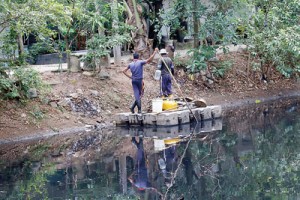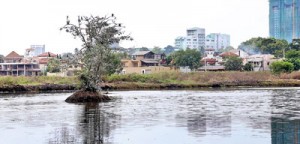Lament for a littered ‘lake’
 The messenger bird in the 15th century epic poem- Selalihini Sandeshaya (Grackle Letter) composed by the monk scholar Ven. Thotagamuwe Sri Rahula Thera pays homage to the fauna and flora of the Kotte Kingdom as it soars into the blue skies. The legend says that the grackle carried a letter to God Vishnu who reigned over Dondra to intervene in finding a suitable marriage partner for the eldest daughter of the then Kotte monarch- King Parakramabahu VI. The grackle’s celebration of the Diyawanna Oya and the natural landscape which surrounds it holds testimony to the rich biodiversity the locale claimed since the times of our ancient monarchs.
The messenger bird in the 15th century epic poem- Selalihini Sandeshaya (Grackle Letter) composed by the monk scholar Ven. Thotagamuwe Sri Rahula Thera pays homage to the fauna and flora of the Kotte Kingdom as it soars into the blue skies. The legend says that the grackle carried a letter to God Vishnu who reigned over Dondra to intervene in finding a suitable marriage partner for the eldest daughter of the then Kotte monarch- King Parakramabahu VI. The grackle’s celebration of the Diyawanna Oya and the natural landscape which surrounds it holds testimony to the rich biodiversity the locale claimed since the times of our ancient monarchs.
Sri Jayawardenepura Kotte and its surroundings are still known as a hub of water bodies, cocooned in marshy swamps with abundant wildlife. The placard erected by the Department of Wildlife at the turn to Parliament Road, speaks for the rich biodiversity among which are endemic species as well. Added to the natural water bodies is the network of canals – a colonial legacy from the Dutch. The canal network facilitated not only the transportation of goods, but acted as a buffer against floods. Over centuries, the buffer zones besides these canals connecting to other internal water bodies have been encroached by illegal settlements, completely oblivious to the original purpose the colonial masters espoused. To make matters worse, these canals have been reduced to garbage disposal pits, not only raping the waters but destroying the marine life.
The Heen Ela flowing through Rajagiriya is an integral part of Colombo’s canal system dating back to the Dutch era. Turning into Lake Drive, opposite McDonald’s, Rajagiriya, one can take a ride parallel to Heen Ela, but the waters stagnate and emanate an odour today. The Heen Ela which falls onto the water retention area (bluntly called the lake) from which the road derives its name ‘Lake Drive’ is or rather was once a home to many species of animals dependent on this water body: Herons, storks, kingfishers.
Now the banks of the Heen Ela water retention area is an eyesore, a haven for the dengue mosquito with a cocktail of garbage including plastic, arrack bottles, rubber slippers and old tyres, fished out of the waters, reminding one of the prophetic words of the Red Indian Chief Seattle; ‘continue to contaminate your bed and one night you will suffocate in your own waste..’
The ravaging of this lowland area and the water retention body found at the end of Lake Drive has become an issue of concern for several ‘nature loving’ and civic conscious residents who alerted the Sunday Times. Arefa Tehsin, ex-hony. Wildlife Warden of the Udaipur District, Rajasthan and daughter of the conservationist Dr. Raza Tehsin, who is presently based here, laments the loss of habitat in Lake Drive, particularly in the water front. “The lake (water retention area) is a complete mess here with industrial and municipal contamination largely being the cause of this. The stench is unbearable at times,” says Arefa who lobbies equally for the community and the wildlife so dependent on the water body. She bemoans the loss of habitat for several creatures including monitor lizards, turtles and even the regular visitor to the compound- the alligator.
According to Arefa, sewage from the houses of the area goes “unchecked and unregulated” to this water body and the canal and even effluents from a nearby industry are released to the canal periodically. “It is a big health hazard not only for the residents but also for the workers who have to wade in the sewage and clean the canal daily and a threat to the animal life,” she adds. Arefa also maintains that the road being built up through Lake Drive, connecting to Kirimandala Mawatha in Nawala has resulted in “mindless destruction of trees and mangroves”, displacing many animals. “We recently had a land monitor whose eyes and mouth had been severed by a crane or a passing vehicle and we had it sent to the Dehiwela Zoo hospital,” she says, questioning if an Environmental Impact Assessment of the road project which runs across one of the last remaining environmentally sensitive zones in the heart of Colombo had been done.
Another resident, Hiran Cooray asserts that a sustainable solution should be found as a way forward. “It is not fair to expect the authorities to be solely responsible for the irresponsible behaviour of the culprits. Nor is it fair to point fingers at only one cross section of the community.
The want of the hour is awareness, a more effective garbage disposal system and a deterrent mechanism in place for the pollution of this magnitude.” Mr. Cooray said that despite the great labours taken by the cleaners who are compelled to wade through this polluted water and manually pull the garbage with tractors, a colossal amount of non-degradable waste is discharged to the waterways. “We cannot be blind to the fact that these workers are also at a huge health risk and have to bear the brunt of insensitivity of the community.”
Richard Mundy had been living on Lake Drive with his wife for the past 14 years and is concerned over possible dengue threats that could be triggered by coconut shells, rubber tyres and plastic containers fished out of the canal. “These were precisely the articles which we were told not to leave lying around during dengue prevention campaigns.” He also recalls seeing a ‘regular boat’ which would collect water samples to be tested for water quality as they moved to the area, which however had gradually stopped coming after a few years. “The water then appeared to be cleaner and certainly had less solid waste floating in it,” says Richard who suspects untreated sewage in the waters today, judging by the foul smelling oily scum which floats in it. “It is obvious that real efforts are being made to maintain the waterways and surrounding areas, but prevention of further pollution must be a major concern as the waterways and surrounding areas support a lot of wildlife and a thriving population of fish.”
Speaking to the Sunday Times, Chairman, Sri Lanka Land Reclamation and Development Corporation (SLLRDC), Asela Iddawela noted that the prime challenge for the SLLRDC which is responsible for canal management, is winning over the pollutants. “When walking further interior in this wetland, we can see the remnants of what people have eaten and drunk- there is plastic and polythene galore and our challenge is to convince the polluter to adopt correct means of disposal.”
Despite the Heen Ela water retention being cleaned regularly by SLLRDC personnel with administrative assistance provided by the SL Navy and Civil Defence Force, the mechanism of manual cleaning cannot be sustained, points out the SLLRDC Chairman. The cleaning personnel are provided with personal protection safe gear to guard themselves against possible skin diseases, says Mr. Iddawela who adds that they are quite susceptible to such diseases as chemicals found in the polluted water could be lethal.
It is learnt from the canal cleaning staff of the SLLRDC that no amount of cleaning which is regularly done will answer as long as pollutants keep on soaring. “We keep on pulling all this non-degradable wear from the waters but the garbage is continuously thrown,” said one of the supervisors. The waste unearthed from the wetland is presently taken to the Meethotamulla garbage dump. A colossal amount of funds is annually allocated by the SLLRDC for the management of canals coming under its purview. According to the SLLRDC figures, Rs. 470 million had been spent in 2016 while another 350 million is allotted for 2017.

Pelicans and other water birds: How long will they survive in these polluted waters?
Community awareness, targeting the next generation is already initiated through their community-supervision officers by means of education programmes and keeping canals clean as part of good house-keeping methods. A dialogue with the Castle Street Maternity Hospital for scientific disposal of clinical waste in a waste park in Muthurajawela is also on the cards. It’s further learnt that this proposed Waste Park will facilitate the modern means of clinical waste disposal from the National Hospital as well. The SLLRDC Chairman also pointed out that a cost-effective waste disposal system aligned with the municipal councils of Colombo and Kotte is also envisaged.
The Heen Ela water retention area on Lake Drive which was preserved under the Great Colombo Flood Control and Environment Project,is a lowland as well, explains Mr.Iddawela. “Although the SLLRDC and several other authorities including the Urban Development Authority (UDA) and Provincial Road Development Authority (PRDA) are blamed for constructing a roadway (which connects to the Nawala Road) which is a hindrance to the residential area we need to remind that the road runs through the canal reservation on which road construction is authorized. Nevertheless we are conscious of safety and convenience of the residents, the reason why a considerable buffer area is planned alongside the road for parking of vehicles,” he elaborated.
The road project is funded by the RDA, the PRDA and SLLRDC are jointly responsible for the construction. “While SLLRDC is responsible for the gabion walls (for the strengthening of the canal bank), PRDA is entrusted with the remaining road construction.” Under the Megapolis 2015-2030 Plan, the new roadway is aimed at reducing traffic congestion.
In response to the alleged charges of ‘filling up of the wetland’ due to road construction by some of the residents in the area, Deputy General Manager (Wetland Management), SLLRDC, Dr (Eng). N.S. Wijerathne said there was no filling up of the wetland. “We are only strengthening the canal bank along Heen Elawhich is inevitable when a project of this nature takes place.” As to whether an Environmental Impact Assessment was done prior to construction of the roadway, Dr.Wjierathne responded that such assessment was not done as the wetland area is not affected by construction. “This however does not mean that we are on a rampage felling trees. We are mindful of the disturbance caused to the biodiversity, the reason why we have root-balled certain trees and replanted them in the Biodiversity Park in Thalawatugoda (adjacent to Ape Gama) and planning another replanting project once the road construction is over.”
Dr.Wijerathne also noted that in terms of rampant water pollution in Colombo’s internal water bodies which eventually flow to Kelani river, the situation is alarming. Although non-degradable waste cannot be underpinned, the chemicals mixed in water are the worst feared pollutants, he said. “Recent studies on the Kelani River basin reveal that pesticides and chemicals are the deadliest pollutants,” reminds Dr.Wijerathne who urges for more responsible community involvement in protecting the water bodies.
| Killing nature, killing us By Arefa Tehsin  Arefa Tehsin While looking for a house in Colombo, I fell in love. It was with the small lake made by the convergence of canals, tucked away at the fag end of Rajagiriya’s Lake Drive. A green patch, the lung of this suburb and house to an astounding variety of critters, big and small. But love often results in heartburn I’m told and that’s what happened. One of the best things about this lake is the peace. Not silence, of course. The roll call of birds is the first thing you hear in the morning. As the day progresses, pelicans let out a guttural cry now as they waddle by clumsily. The jungle crows caw trying to steal some sticks from the garden broom for their nest. The squirrels let out a sharp chick-chick-chick with jerks of their tail if someone as much as eyes their famous nut. The mynahs go about looking like bandits but when they open their mouths they are nothing but songsters. The tui-tui crying parakeet smooches his girl as if there is no tomorrow. (Our current protectors of morality will faint at this grossly impolite behaviour!). The purple moorhens scold in a grandmotherly voice if you go too close. Our local Mozart, koel, reaches hysterical pitches trying to impress a girl who just eyes him critically. A Brahminy kite lets out a scream from the skies just for kicks. And there are the silent ones too. Like the water monitor lizard who tries to approach an egret waiting for fish with clumsy stealth. Like the gentle fireflies who rise at night like little twinkling faeries. A reality show of animal lives happening all around you (drama, squabble, sex, haggling, luring, deceiving, hunting and being hunted), if you have the patience to watch long hours. A porcupine was spotted in the area. Some claimed of seeing the resident croc too. This was all rosy, but the heartburn came soon enough. When reality struck. When pungent waste, which looks toxic, came floating by for the first time. And then again. And again. When water hyacinth, that thrives in dirty waters, spread and took control of the lake. “So what’s new?” the older residents of the area shrugged their shoulders. There has been a constant war that wages between the workers who clean this lake and this water hyacinth and floating waste. During the recent floods, when Lake Drive was flooded and our garden submerged in water, the biggest concern was the rancid water entering our pump. All the vegetable plants in our garden wilted and died with the first touch of that water. I wonder how the myriad of water and land birds and animals are surviving on these polluted waters. Big sewage pipes (and small underground ones) constantly empty the house waste in the canals and lake. An oil refinery, I’m told, discharges its waste in the canal periodically. We may stuff our noses when the stench assaults our senses, or shut down the water pump when the garden floods. I wonder what the yogic grey heron, who meditates in water the whole day, is supposed to do. Or the kingfishers, waterhens, cormorants, river turns, night herons, snake birds, barbets, babblers, orioles or the other migratory birds who seek home in this water body every year are supposed to do? We are pushing the remaining wildlife out of our cities. And how! What is direly needed is for the authorities to take stern steps to stop the dumping of industrial and house waste in these waters. We are harming ourselves as much as the environment. When I sit with my freshly baked fish, sometimes my eyes wander to the fishing boat in the lake casting its net. I realise it then. When you throw shit about, it invariably ends up on your table. ( The writer is an author, columnist and ex-hon. Wildlife Warden – Udaipur, India) |


